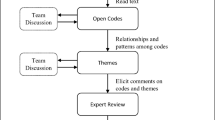Abstract
This article outlines some of the findings based on a study by three teachers and a university academic of role play in the teachers' classes. The study focuses on the results of role plays undertaken with students in mixed ability classes from three high schools in New South Wales. Role plays, where students play parts in scientific phenomena such as the electrons in an electric circuit or molecules from food in digestion, are not new to science education. But, what happens when students participate in role plays in science? In this report it is suggested that simulation-role-play may allow students to demonstrate their understanding, explore their views and develop deeper understanding of phenomena. A strategy for using analogical analysis in simulation-role play is suggested but concerns are raised about the students' capacity to distinguish role play from the subject matter being studied.
Similar content being viewed by others
References
Badcock, C. (1995).PsychoDarwinism; The new synthesis of Darwin and Freud. London: Harper Collis.
Bell, B. (1993).I know about LISP but how do I put it into practice? Final report of the learning in science project: Teacher development Hamilton: Centre for Science and Mathematics Education Research, Waikato University.
Boomer, G. (1988).Teachers learning: Improving Australian schools through inservice teacher training and development. Canberra: AGPS.
Chester, M., & Fox, R. (1966).Role playing methods in the classroom. Chicago: Science Research Association.
Cobern, W. W. (1993). Contextual constructivism: The impact of culture on the learning and teaching of science. In K. Tobin (Ed.),The practice of constructivism in science education. Washington, DC: American Association for the Advancement of Science.
Cole, A. (1989). Researcher and teacher: Partners in theory building.Journal of Education for Teaching, 15, 225–237.
Dawson, C. (1991).Beginning secondary science teaching. Melbourne: Longman Cheshire.
Duit, R. (1991). On the role of analogies and metaphors in learning in science.Science Education, 75, 649–672.
Eisenberg, A., (1992). Metaphor in the language of science.Scientific American, May, 95.
Erickson, F. (1986). Qualitative methods in research on teaching. In M. C. Wittrock (Ed.),Handbook of research on teaching (3rd ed.) (pp. 119–161). New York: Macmillan.
Erickson, G. (1991). Collaborative inquiry and the professional development of science teachers.The Journal of Educational Thought, 25, 228–245.
Fullan, M., & Stiegelbauer, S. (1991).The new meaning of educational change. New York: Teachers College Press.
Gardner, H. (1983).Frames of mind: The theory of multiple intelligences. New York: Harper & Row.
Gardner, H. (1991).The unschooled mind: How children think and how schools should teach. London: Fontana.
Gick, M. L., & Holyoak, K. J. (1983). Schema induction and analogical transfer.Cognitive Psychology, 15, 1–38.
Goodson, I. (1994). Studying teacher's life and work.Teaching and Teacher Education, 10(1), 29–37.
Harrison, A. G., & Treagust, D. F. (1994). The three states of matter are like children at school.Australian Science Teachers Journal, 40, 20–23.
Hiotis, H. (1993). Using creative writing and drama to learn science.Australian Science Teachers Journal, 39, 37–40.
Hildebrand, G. M. (1989). Creating a gender inclusive science education.Australian Science Teachers Journal, 35, 7–16.
Holyoak, K. J., & Thagard, P. (1995).Mental leaps: Analogy in creative thought Cambridge: Bradford.
Kagan, D., Freeman, L. F., Horton, C. E., & Rountree, B. S. (1993). Personal practices and perspectives on a school-university partnership.Teaching and Teacher Education, 9(5/6), 499–509.
Ladrousse, G. P. (1989).Role play. Oxford: Oxford University Press.
Lincoln, Y. S., & Guba, E. G. (1985).Naturalistic inquiry. Beverly Hills: Sage Publications.
Plotkin, H. (1994).The nature of knowledge: Concerning adaptations, instinct and the evolution of intelligence. London: Penguin.
Tobin, K. & Fraser, B. J. (1988). Investigations of exemplary practice in high school science and mathematics.Australian Journal of Education, 32(1), 75–94.
Treagust, D. F. (1993a, July).The importance and use of analogies in teaching and learning science more effectively. Paper presented at the annual meeting of the Australasian Science Education Research Association, Lismore, NSW.
Treagust, D. F. (1993b). The evolution of an approach for using analogies in teaching and learning science.Research in Science Education, 23, 293–301.
Yager, R. E., & Lutz, M. V. (1994). Integrated science: The importance of “how” versus “what”.School Science and Mathematics, 94, 338–346.
Yager, R. E. (1989). A rationale for using personal relevance as a science curriculum focus in schools.School Science and Mathematics, 89, 144–156.
Author information
Authors and Affiliations
Corresponding author
Rights and permissions
About this article
Cite this article
Aubusson, P., Fogwill, S., Barr, R. et al. What happens when students do simulation-role-play in science?. Research in Science Education 27, 565–579 (1997). https://doi.org/10.1007/BF02461481
Issue Date:
DOI: https://doi.org/10.1007/BF02461481




